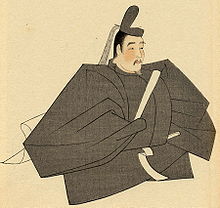Minamoto no Sanetomo
Minamoto no Sanetomo 源 実朝 | |
|---|---|
Shōgun | |
| In office 1203–1219 | |
| Monarchs | Tsuchimikado Juntoku |
| Shikken | Hōjō Tokimasa Hōjō Yoshitoki |
| Preceded by | Minamoto no Yoriie |
| Succeeded by | Kujō Yoritsune |
| Personal details | |
| Born | September 17, 1192 |
| Died | February 13, 1219 (aged 26) |
| Nationality | Japanese |
| Spouse | Bomon Nobuko |
| Parents |
|
| Signature |  |
| Military service | |
| Allegiance | Minamoto clan |
| Branch/service | Minamoto clan |
Minamoto no Sanetomo (源 実朝, September 12, 1192 – February 13, 1219, r. 1203–1219) was the third
His childhood name was Senman (千万). He was the last head of the Minamoto clan of Japan. His Dharma name was Daijijiden seini'i goshoko jingi (大慈寺殿正二位丞相公神儀).
He was an accomplished waka poet.
Early life

This section needs additional citations for verification. (March 2018) |
After the death of Yoritomo in 1199, Sanetomo's grandfather
A year later, Yoriie was assassinated by the Hōjō. Sanetomo was never more than a puppet for his mother Hōjō Masako, who used him as a pawn in her war with her father Tokimasa; Tokimasa tried to depose his grandson a number of times, beginning in 1205, causing Sanetomo to fear for his life thereafter.[citation needed]
Waka poet
Sanetomo, understanding his own powerlessness and not wanting to meet the same fate as his brother, put his time and energy into writing
Eventually, Sanetomo lapsed into inactivity and despair, plagued by fear of assassination and tormented by his chronic alcoholism (an addiction which Priest Eisai once tried to break by replacing alcohol with tea).[citation needed]
Death


Under heavy snow on the evening of February 13, 1219 (
Minamoto no Sanetomo was succeeded by Kujō Yoritsune as fourth shōgun of the Kamakura shogunate.
Family
- Father: Minamoto no Yoritomo
- Mother: Hōjō Masako
Eras of Sanetomo's bakufu
The years in which Sanetomo was shogun are more specifically identified by more than one
- Kennin (1201–1204)
- Genkyū (1204–1206)
- Ken'ei (1206–1207)
- Jōgen (Kamakura period) (1207–1211)
- Kenryaku (1211–1213)
- Kenpō (1213–1219)
- Jōkyū (1219–1222)
See also
Notes
- ^ Nussbaum, Louis-Frédéric. (2005). "Minamoto no Sanetomo" in Japan Encyclopedia, pp. 633–634, p. 633, at Google Books
- ^ a b c Azuma Kagami; Mutsu (1995/06: 102-104)
References
- Azuma Kagami, accessed on September 4, 2008; National Archives of Japan 特103-0001, Digitized image of the Azumakagami (in Japanese)
- Brinkley, Frank; Kikuchi, Dairoku (1915). A history of the Japanese people from the earliest times to the end of the Meiji era. The Encyclopædia Britannica Co.
- 神谷道倫 (2006). 深く歩く鎌倉史跡散策上. かまくら春秋社. ISBN 978-4-7740-0340-5.
- Jeffrey P. Mass (1995). Court and Bakufu in Japan. Stanford University Press. ISBN 978-0-8047-2473-9.
- David Murray; Kentarō Kaneko (1906). Japan: Continuing the history to the close of 1905, with the provisions of the treaty of Portsmouth between Russia and Japan, and supplementary chapters. Putnam. p. 504.
- Mutsu, I. (1995). Kamakura: Fact and Legend. PeriplusEdition. ISBN 978-0-8048-1968-8.
- OCLC 1014075
- Frédéric, Louis; Roth, Käthe (2002). Japan enciklopedia. Harvard University Press. ISBN 978-0-674-01753-5.
- Rin-siyo, Siyun-zai (1834). Annales des empereurs du Japon. Oriental Translation Fund.
